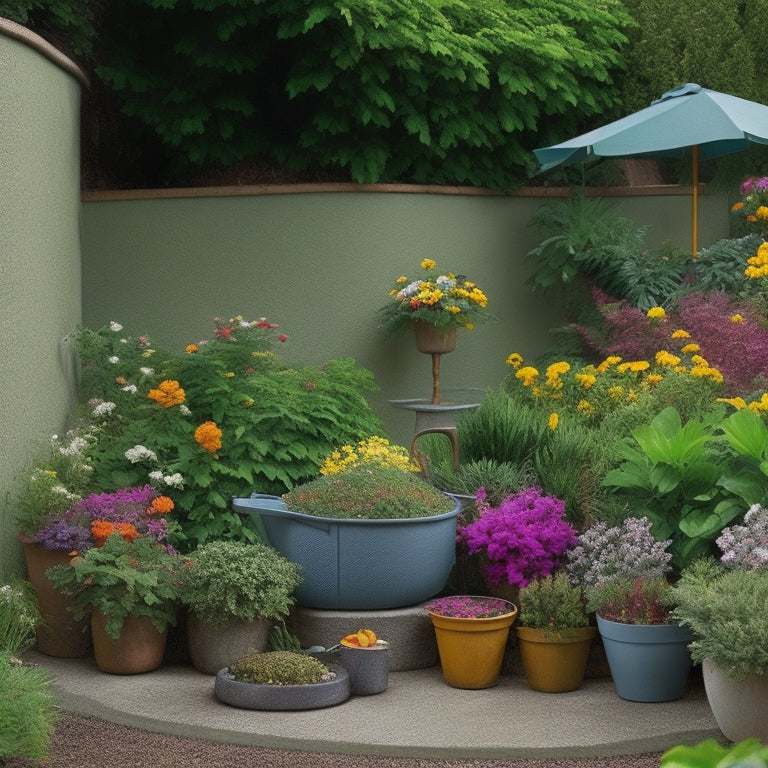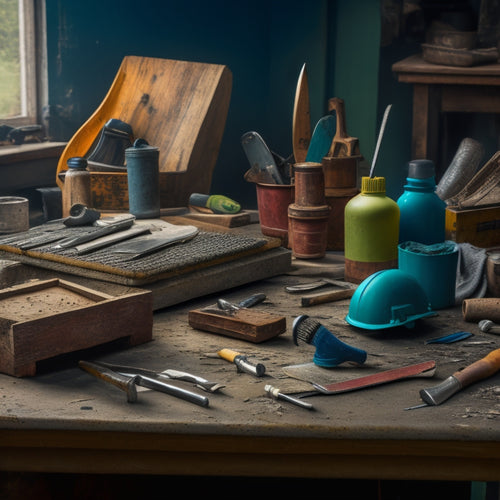
5 Best Affordable Tools for Concrete Garden Walls
Share
To build a stunning concrete garden wall on a budget, you'll need a strategic combination of essential hand tools like trowels, edgers, and chisels to achieve smooth surfaces and defined lines. Affordable power tools like circular saws, reciprocating saws, and rotary hammers will considerably speed up your work. Budget-friendly mixing and pouring tools, such as mixing buckets and pouring chutes, will help you achieve a precise, flat surface. Don't forget cost-effective finishing tools like tampers and floats to create uniform textures, and must-have safety equipment like gloves, safety goggles, and dust masks to protect yourself. As you master these tools, you'll open up new possibilities for creative expression and unique designs.
Key Takeaways
• A sturdy mixing bucket and drill with mixing paddle are essential for uniform concrete mixing at an affordable price.
• Invest in a trowel, edger, and small trowel for achieving smooth, even surfaces and clean lines in your concrete garden wall.
• A cordless circular saw or reciprocating saw from brands like DeWalt, Makita, or Bosch can efficiently cut and shape concrete without breaking the bank.
• A tamping tool, float, and edger are cost-effective finishing tools for compressing, smoothing, and defining the boundaries of your concrete wall.
• Don't forget to prioritize safety with affordable protective gear like safety goggles, gloves, and a dust mask or respirator to prevent injuries and health issues.
Essential Hand Tools for Concrete
You'll need a robust set of hand tools to shape, smooth, and finish your concrete garden wall, including a trusty trowel, edger, and float.
Mastering trowel techniques is vital for achieving a smooth, even surface. Hold the trowel at a 45-degree angle and use a gentle, sweeping motion to spread and level the concrete. For tight spaces and corners, switch to a smaller, more agile trowel.
When it's time to add texture or create a decorative edge, reach for your edger. This tool is designed to create clean, defined lines and can be used to create a variety of patterns and designs.
For more complex designs or repairs, concrete chiseling may be necessary. Use a sturdy chisel and hammer to carefully remove excess concrete and create the desired shape.
Remember to always wear protective gear, including gloves and safety glasses, when working with concrete.
With these essential hand tools and a bit of practice, you'll be able to achieve professional-looking results on your concrete garden wall.
Affordable Power Tools for Walls
As you move beyond hand tools, a range of affordable power tools can considerably speed up and simplify the process of building and finishing your concrete garden wall. With the right power tools, you'll be able to cut, drill, and shape concrete with ease.
Here are some affordable power tool options to evaluate:
| Tool | Brand | Cordless Option |
|---|---|---|
| Circular Saw | DeWalt, Makita | ✅, ✅ |
| Reciprocating Saw | Bosch, Milwaukee | ✅, ✅ |
| Rotary Hammer | Hilti, DeWalt | ❌, ✅ |
When choosing a power tool, reflect on the brand's reputation for quality and durability. DeWalt, Makita, Bosch, Milwaukee, and Hilti are well-known power tool brands that offer affordable options. Additionally, look for cordless tool options, which provide greater flexibility and convenience. Cordless tools are ideal for working in areas with limited access to power outlets or for tasks that require frequent movement. By investing in a few affordable power tools, you'll be able to tackle complex tasks with confidence and efficiency.
Budget-Friendly Mixing and Pouring
Mixing and pouring concrete efficiently requires the right tools and techniques to achieve a strong, uniform finish, and affordable options are available to help you get the job done.
You'll need a sturdy mixing bucket, a reliable drill with a mixing paddle, and a pouring chute or trough to direct the concrete flow.
When it comes to mixing techniques, you'll want to use a consistent, figure-eight pattern to guarantee all ingredients are well combined. Avoid overmixing, as this can lead to a weak, porous finish.
For pouring methods, consider using a chute or trough to control the flow of concrete, especially when working with vertical walls. This will help prevent spills and guarantee a smooth, even finish.
You can also use a level and a screed board to achieve a precise, flat surface. By mastering these mixing and pouring techniques, you'll be able to achieve professional-looking results without breaking the bank.
With the right tools and techniques, you'll be well on your way to building a beautiful, durable concrete garden wall that will last for years to come.
Cost-Effective Finishing Tools Needed
With a smooth, even pour achieved, it's time to focus on the finishing touches, where a set of cost-effective tools can help you achieve a professional-looking finish that showcases your concrete garden wall's unique texture and color.
To achieve the desired finish, you'll need the right tools for the job. Here are some essential finishing tools that won't break the bank:
| Tool | Description |
|---|---|
| Tamping Tool | Use to compress and smooth out the concrete, creating a uniform texture. |
| Edger | Perfect for creating clean edges and defining the boundaries of your wall. |
| Float | Helps to flatten and even out the surface of the concrete, preparing it for further finishing techniques. |
These tools will help you achieve a range of finishing techniques, from a smooth, glossy finish to a more textured, rustic look. With the right tools and a little practice, you can create a stunning concrete garden wall that showcases your unique style and adds value to your outdoor space. By experimenting with different texture options and finishing techniques, you can create a one-of-a-kind feature that adds depth and visual interest to your garden.
Must-Have Safety Equipment Options
Before you start working on your concrete garden wall, outfit yourself with essential safety gear to protect your eyes, skin, and respiratory system from the hazards of concrete dust and heavy materials.
You'll need safety goggles to shield your eyes from flying debris and concrete particles. Look for goggles with anti-fog coatings and good optical clarity to guarantee you can see what you're doing.
Next, invest in a pair of protective gloves to safeguard your hands from cuts, abrasions, and cement burns. Opt for gloves with grip patterns on the palms to prevent slipping and dropping heavy tools or materials. Consider gloves with reinforced palms and fingers for added protection.
Don't forget to wear a dust mask or respirator to filter out concrete dust and other airborne particles that can irritate your lungs. A good quality mask should have a HEPA filter or equivalent to capture 99.97% of particles as small as 0.3 microns.
Frequently Asked Questions
Can I Use a Regular Drill for Mixing Concrete?
You can't use a regular drill for mixing concrete; it'll burn out quickly. Instead, opt for a heavy-duty drill or a mixing drill with a paddle bit, and employ a slow, sweeping mixing technique to avoid air pockets.
Do I Need a Permit to Build a Concrete Garden Wall?
As you stand amidst the dusty, ancient ruins of a forgotten civilization, you ponder: do you need a permit to build that concrete garden wall? Check local construction regulations, as permits are often required for walls exceeding 3-4 feet in height.
How Do I Prevent Efflorescence on My Concrete Wall?
To prevent efflorescence on your concrete wall, you'll want to apply a waterproofing sealant, ensuring a breathable barrier that allows moisture to escape while preventing water ingress, thereby reducing the risk of unsightly white stains.
Can I Use a Concrete Wall as a Retaining Wall?
You're wondering if your concrete wall can double as a retaining wall, but first, consider the benefits of a dedicated retaining wall, like added structural support, and weigh them against the disadvantages of using a concrete wall, such as potential water damage.
How Long Does It Take for Concrete to Fully Cure?
You'll wait around 28 days for concrete to fully cure, reaching its maximum strength. During this curing time, the mixture transforms, increasing its concrete strength through hydration, ultimately forming a robust, long-lasting structure.
Conclusion
You've got the foundation laid, literally! With these affordable tools, your concrete garden wall is taking shape.
Like a master builder, you've crafted a sturdy structure, and now it's time to add the finishing touches.
Your sweat and toil will soon pay off, as your outdoor oasis begins to bloom.
As the final brick falls into place, step back and admire your handiwork - a proof of your DIY prowess!
Related Posts
-

Must-Have Tools for Laying Concrete Tiles
When laying concrete tiles, you'll need a range of essential tools to get the job done right. Start with subfloor pre...
-

Top Concrete Resurfacing Tools for a Pro Finish
When it comes to achieving a professional finish in concrete resurfacing projects, you require the right set of speci...
-

Must-Have Handheld Tools for Concrete Repair
When tackling a concrete repair project, it is crucial to have the right handheld tools to achieve a professional fin...


